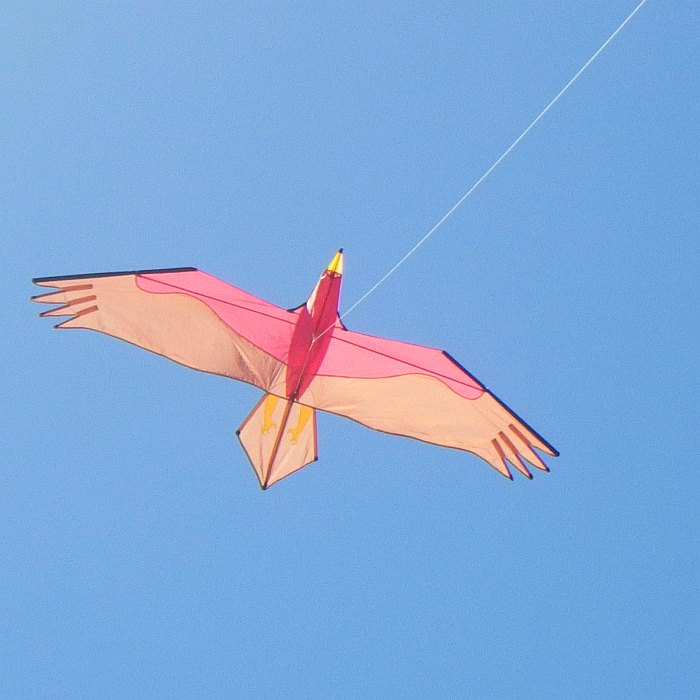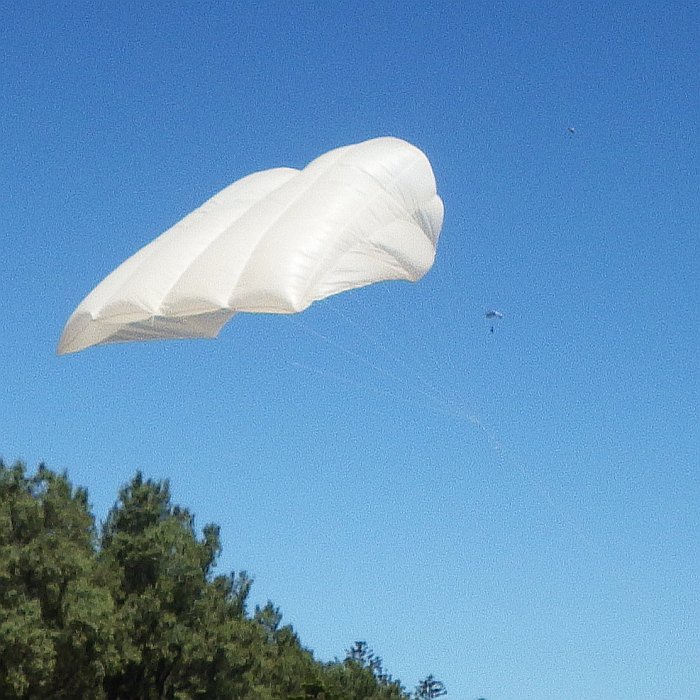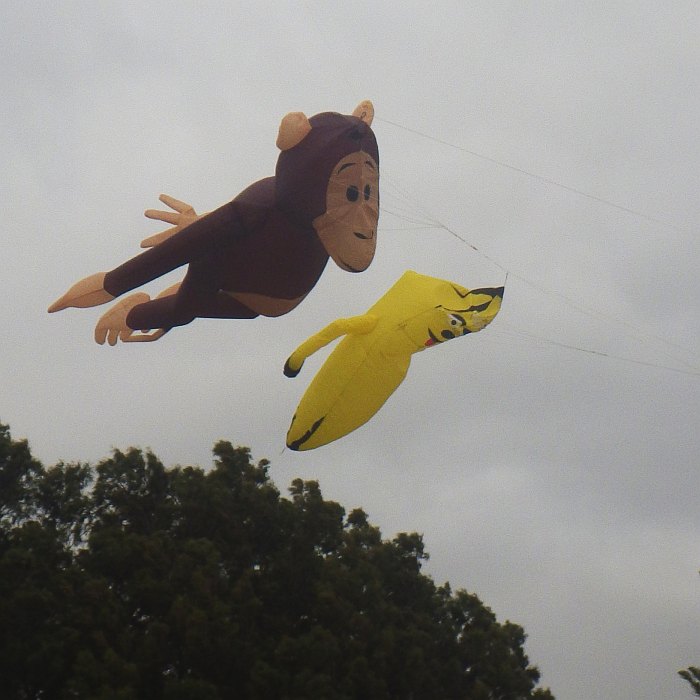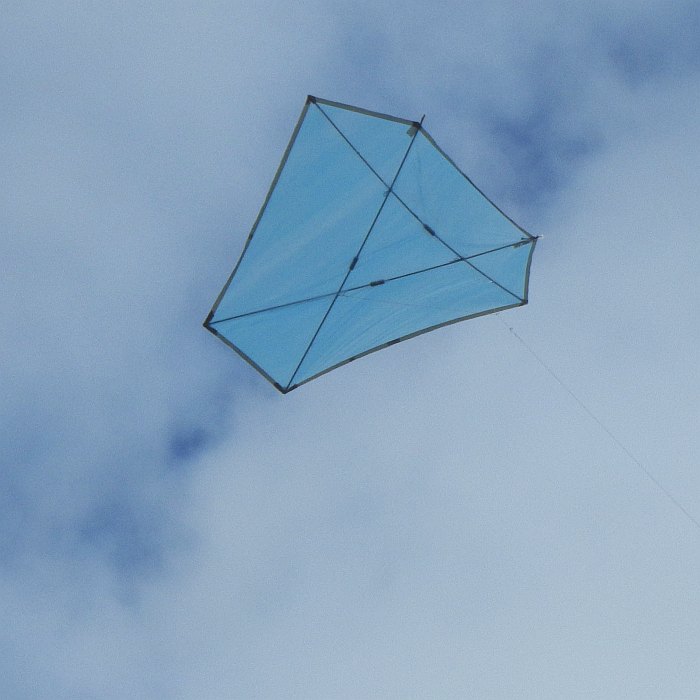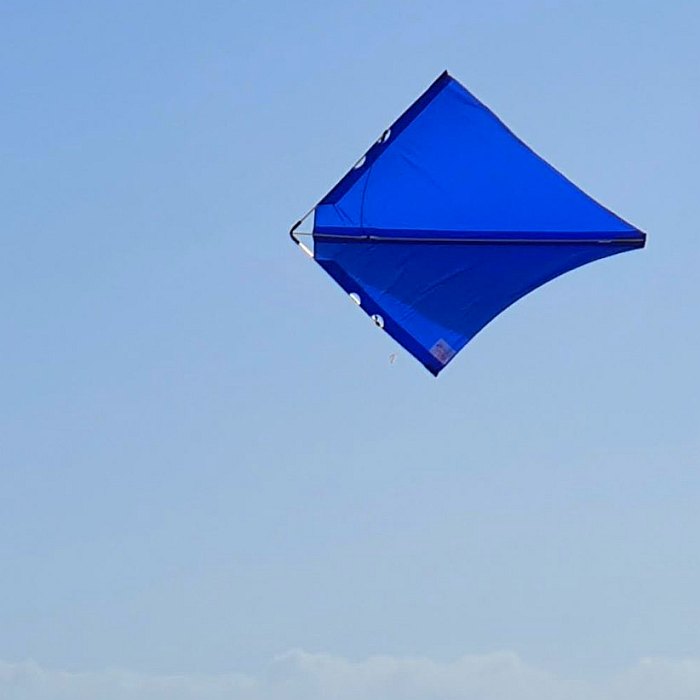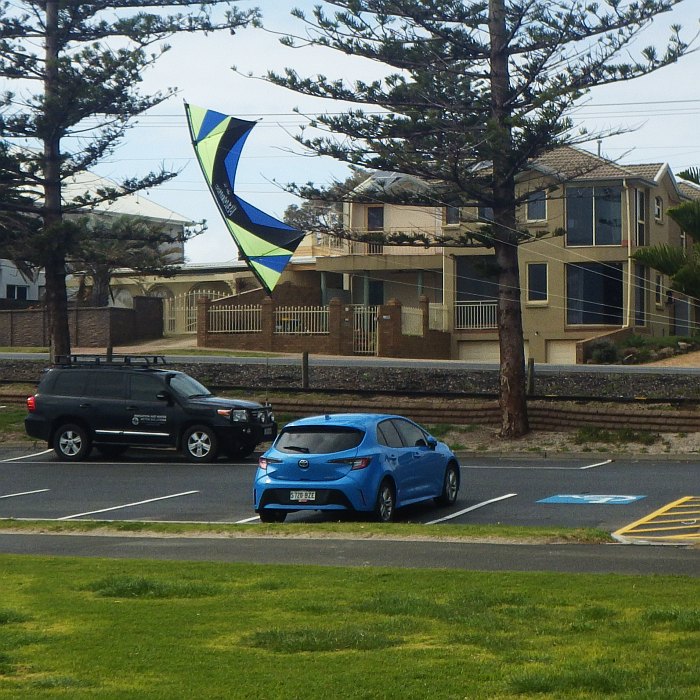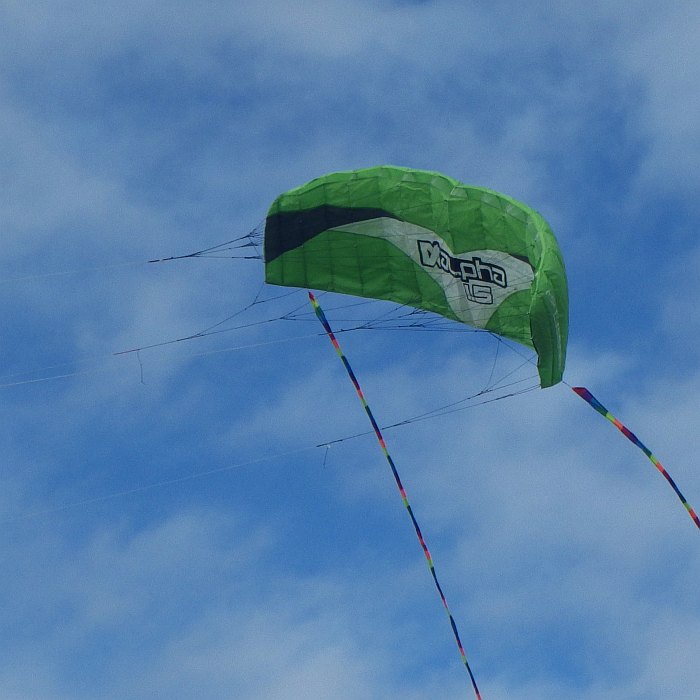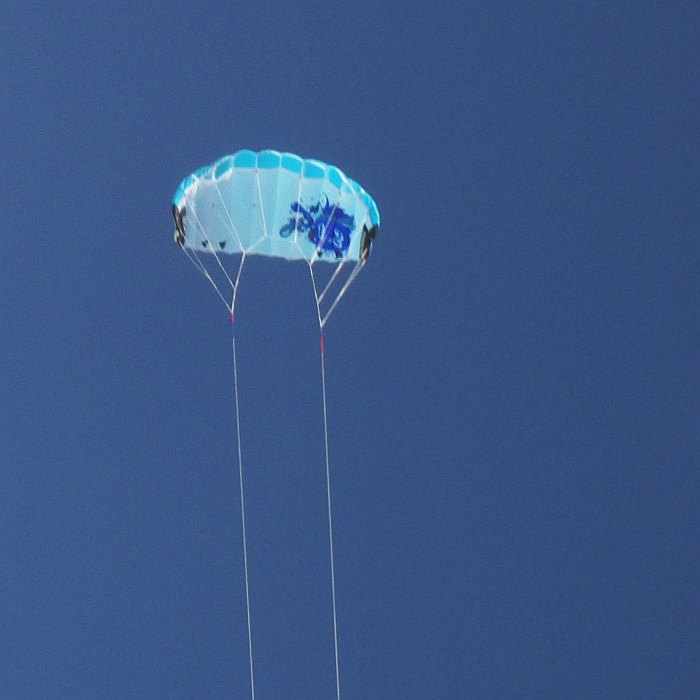AKFA Kite Fly Posts 2019
Adelaide Kite Flyers Association (AKFA). Every second Sunday of the month is a social fly day when (weather permitting) members meet to fly kites at Semaphore South.
These short flight reports once appeared in the site blog page although that blog is no longer being published. Just scroll down and stop at any kiting detail that appeals. :-) There's a photo gallery down near the bottom of this page too.
On this site, there's more kite-making info than you can poke a stick at. :-)
Want to know the most convenient way of using it all?
The Big MBK E-book Bundle is a collection of downloads—printable PDF files which provide step-by-step instructions for many kites large and small.
Every kite in every MBK series.
AKFA Kite Fly—November 2019
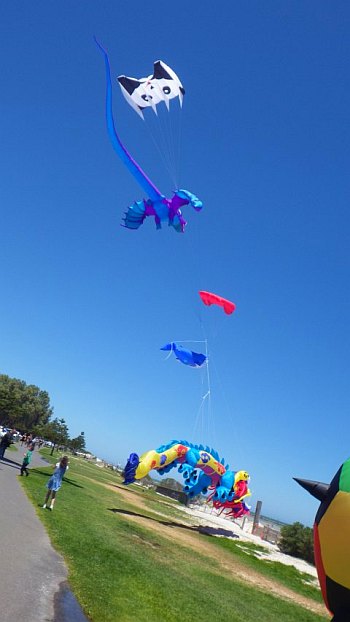 At the beach earlier in the year
At the beach earlier in the yearClub fly day had come around again, but the breeze on the coast was almost non-existent.
Aren and I arrived shortly after 1 pm to find several big parafoils draped over the grassed area. And there was nothing in the air. A short time later, Henry had the light-wind parafoil up for a while, before it too succumbed and sank to the ground. The antics of failing foils can be a touch funny at times. A fold-up and flop isn't much to look at. However, seeing the big white four-cell kite almost gracefully distort and perform a complete slow roll was mildly entertaining for a moment. :-) It all happened just 2 meters (6 feet) or so above the grass.
Andy's parafoil got some air in the intakes but refused to get much height. Alli's parafoil had slightly heavier fabric and managed to hover at head height for a few moments. Mike had a bit more success with his light-wind eagle, which he keeps on hand for days like this.
Mark had his big colorful delta in the air a bit later, while I rigged the ponderous blue Multi-Dowel Delta. This is a 5-meter (16-foot) span plastic-and-dowel beast, which is happy to flop around in very light conditions. Mark and I both did a few minutes of constant line-working, trying to keep our kites off the grass.
Soon both Mark and I were down on the sand, taking advantage of the far greater towing space out there. The tide wasn't too far in, so that was a plus. Eventually, it was just me down on the sand. I ended up close to the lapping water, with well over 90 meters of line out. The huge delta was right on its lower limit of wind speed, but from time to time it was possible to urge it up to almost a 45-degree angle. At other times, the big dark-blue craft would glide left and right, low down over the dunes as I let out line and waited for another opportunity to climb back up high.
Back in the car park, several sets of eyes were on the big delta, since it was giving clues as to when another launch could be attempted with those big parafoils! However, wind speeds low over the grass were never really sufficient, and so people began leaving well before 4 pm.
So an extended very-light-wind workout it was. However, a steady light breeze had set in by the time the last of us was leaving. :-|
AKFA Kite Fly—August 2019
Rain and shifting sand didn't get in the way of a good afternoon's club flying.
Initially, Mike had the four-cell red parafoil up, with a red gecko inflatable attached quite close to the kite. In the moderate breeze, the combination proved a little unstable, with the parafoil shifting far to the right and left. Then while getting my Peter Powell stunter set up, a squall came through, sprinkling light rain over the local area. This was accompanied by quite a substantial increase in wind speed. Down went the parafoil and inflatable, which Mike duly packed up some time later.
As the rain disappeared so did the breeze. Well, not completely... In the light conditions that remained, Michael (not Mike) and I put up small sleds. Mine was the MBK Soft Sled that anyone can make, while Michael's was a Prism para-sled.
As time wore on, the original breeze strength gradually returned. With my little sled slightly out of trim and on 60 meters (200 feet) of line, it was in danger of being forced over to the right and into tall trees. Hence the line was shortened to keep out of trouble.
And then another squall came through! We all sat that one out in our cars as loose sand blew along the beach and light rain returned.
Finally, a smooth moderate-to-fresh breeze blew almost straight along the beach. That was perfect for sport kites of any description! Mike had a soft four-liner going with twin tubular tails. Michael pulled out a small two-line foil, while Aren and I had fun with the Peter Powell Mk3 steerable diamond. With the ample breeze, we of course had the 100-foot tubular tail attached! I practiced wide loops, square loops, horizontal eights, and vertical eights. All these were done in both directions to avoid building lop-sided skills. :-| The blue diamond managed to clip a sand dune and keep flying on one very low pass from left to right. It was all good fun.
Michael had been kind enough to lend me a set of Dyneema lines for the PP Mk3. They certainly made a positive difference to the handling although the kite is perfectly well-behaved on polyester too. Flying with polyester is rubbery but easily controllable.
AKFA Kite Fly—July 2019
Yesterday at Semaphore South we had the usual club kite-fly.
However, with a stiff southwesterly, we all opted for dual-line kites! Although Mike had the ever-present red parafoil up with some inflatables strung from the line, he also flew a medium-sized foil over the grassed area.
Recent member Shah was there too, with a good-quality delta sport kite. The kite was hard to miss, fitted with a tube tail from each tip plus a much longer one from the tail end of the spine. Starting over the grass, Shah later opted for flying from the sand for a bit more room. However, even the area over the sand was diminishing as a high tide crept in.
I pulled out my Peter Powell Skystunter Mk3 and with Aren's help launched it into the smooth wind on short lines. The kite had the classic 100 foot tubular tail attached of course. :-) That got some attention as the concept has done since the original Peter Powell kite craze swept the world in the late 1970s.
I tried out some vertical and horizontal eights, square loops in both directions, and of course the usual super-low passes across the sand. With any kind of aircraft, there's nothing like a bit of low-level flying. :-)
Aren had a good fly too, trying tight loops in both directions. Like me, he almost lost it during a dive toward the sand, avoiding a mishap by centimeters!
After this, we handed over to Michael C. who soon got a feel for low passes and steep line angles with the high-quality diamond dual-liner. Even on the shortened length, he noticed that he wasn't flying on Dyneema, though! I'll need to fix that at some point to get some more precision into the figures. OK, it's mainly practice, but having more positive control will surely help.
Finally, a rain shower had us all scrambling to pack up in the very chilly conditions.
AKFA Kite Fly—May 2019
It was just as well that we came prepared with some reasonably low-wind kites yesterday.
Mike had the club red parafoil up, which was suspending his hammerhead shark semi-flying inflatable. A ball inflatable also dangled close to the sidewalk (footpath), which provided entertainment for small kids walking past. One child even managed to catch it, much to the consternation of the parents who didn't want any damage done. Sewn ripstop is reasonably tough, though, as most readers of this post would know.
Later, the ball was swapped for a fish non-flying inflatable suspended from two points along the line. With the breeze somewhat marginal, the white windsock off the fish's fin drooped almost straight down to toward the grass.
Meanwhile, I had rigged the big Multi-Dowel Barn Door kite. Once up, it seemed uncharacteristically unstable, swooping left and right. After bringing it down I noticed that there didn't seem to be as much bow in the horizontal spar as in previous years. Things stretch over time, and perhaps this problem had snuck up on me. :-) In any case, a tiny loop knot in one of the bow lines shortened it enough to fully stabilize the kite.
By now, Mike had moved along the grass a bit and was entertaining people walking by with a small power kite that trailed a couple of tubular tails. Mind you, the soft four-liner was barely able to get up to much of an angle in the slow air. Launching off the ground required a few quick backward steps.
Since the big barn-door was looking after itself well, it was decided to put up the 2-meter (7-foot) tall Carbon Diamond as well. Although heavier than an equivalent ripstop-sailed kite, it has slots and very little billow that make it very efficient in the air. The sail was made from Tyvek housewrap. The stuff is so strong you can't tear it or puncture it easily. The big diamond flew side-by-side with the barn door for perhaps an hour in the very smooth onshore breeze. Both kites were on less than 30 meters (100 feet) of line to avoid potential problems in the car park. :-|
Eventually, when the breeze strength dropped to just 7.5 kph, only the Multi-Dowel Barn Door remained in the air. Things just got even lighter from there, which inevitably brought down the barn door. After that, even my Multi-Dowel Sled failed to launch, let alone stay up.
So it wasn't the greatest show—but at one point there were four kites up at once plus the "laundry," which was something!
AKFA Kite Fly—March 2019
After a morning of tidying up and cataloging the contents of the club storage facility, most of us went down to the beach for the usual monthly kite-fly.
As forecast, the breeze was north-northwest and quite light. It was very light, in fact. Henry's big white parafoil, which normally excels in light wind, could barely stay up.
Others tied straps to the railing in anticipation of anchoring some larger kites. However, there was not much point in dragging more gear out until the wind freshened. A westerly breeze of ample strength was supposed to arrive during the early afternoon, so it was worth waiting around for a bit.
While at the storage facility, I had picked up a Bali bird kite that was deemed too small to be kept with all the other much-larger club kites. Having been shown how it was rigged, I gave it a shot in the on-and-off very light conditions.
The flying line was Larks Head knotted behind the two tiny rings on the bridle. One ring terminated the upper two bridle legs while the other terminated the third bridle leg coming from the spine, near the wing's trailing edge.
On 50-pound line, my bird kite was able to hover around at low line angles. A few pull-ups to higher angles were done, but the air just couldn't sustain it. The kite had many short flights during which I discovered that it could do a nice stable glide on a slack line! A couple of times, the kite flew upwind, descending in almost calm air and was easily caught in one hand. Using 20-pound line would have helped flight times a little, but with almost no wind the end result would have been the same.
Mike managed to resurrect an old flexifoil power kite, using a spar that appeared to match but was missing the end-caps. With some tape and a spare set of lines, the classic foil flew again—helped by plenty of jogging backward!
The white parafoil ended up draped over the fence.
Finally, the wind direction did change, but the speed remained much the same. After some time we all got tired of waiting, so one by one the cars departed. Still at least three kites had made it into the air, so there was definitely an MBK blog post in it. ;-)
AKFA Kite Fly—February 2019
Earlier in the morning there seemed to be a promising amount of breeze. However, on arrival at Semaphore South...
Large kites were lying about on the grass, and nothing was actually in the air. Mike was rigging his trusty wedge-tailed eagle, which performs well in light wind.
Many kite club members were present, but it was just one of those days; there was more sitting around talking than flying!
Not to be deterred, I soon had my red roller rigged and in the air. This roller, with its solid vertical spar and soft Tyvek sails, is not a purpose-built light-wind design, but it's not bad in light winds. There was just enough air movement to get some line out and tug the kite up a few times.
Mike was having some success with the eagle. He was managing to get quite a lot of line out at times, only to be forced to take it all back in now and again!
It was a similar story with my roller, which yo-yoed up and down on just over 30 meters (100 feet) of line. Every few minutes the kite would sink out tail-first to the grass. Moments later, after being held up to the bit of breeze wafting through, up it would go again. One time, a bubble of rising air from the warm sand just upwind floated the kite almost vertically overhead. It was there for just a short while. :-(
On a shorter bridle, the roller would have stayed up longer by floating down on its face during each cycle of the breeze. But I still think it would have ended up on the grass periodically! If I had brought the super-light Dowel Series diamond or delta then one of them might have stayed up the whole time.
Henry's large white parafoil struggled into the air a few times. However, the kite was barely able to start lifting the inflatable attached underneath.
Apart from the lack of consistent wind, the weather was great! Cloud cover was minimal and the air temperature mild, being in the low 20s Celsius.
Perhaps next time the flying will be much better.
AKFA Kite Fly—January 2019
Stiff winds had been forecast from nearly a week ago.
Sure enough, on arrival, the big kites were leaning! It was really a bit much to bring out the usual sparred designs. So my roller and even the Dowel Box were left in the car. Instead, the little MBK Parachute was pulled out. The blue-and-orange plastic 'chute eagerly pulled out line through my hand and was soon weaving around at its usual modest line angle. The thing about this kite, though, is the fact it can absorb over 40 kph of wind speed if necessary!
Mike had his large red pilot kite up fairly high, with a small inflatable whale slung underneath. It was small, that is, as far as whale kites go!
Anchored not far downwind was Ian and Elly's panda flowform, with their giant dragon inflatable floating just off the grass, below—a big, long head-turner, that one.
Steve had been tuning a couple of large sparred kites over previous weeks. Today he had some good results despite exploring the very top of the kites' wind range. Steve had read up, discovered and now demonstrated the advantages of load-bearing vertical spars! This related to kites with at least five bridle legs. It made all the difference with a large bendy rokkaku.
Finally, with the wind gusts pushing well into the fresh range, it was time to take kites down. Also, Andy had tethered a large spiked ball that just bounced around on the grass. For this sizeable piece of wind-art it was just a matter of unzipping the back and squeezing all the air out.
Last down was my trusty high-wind MBK Parachute, which had been tethered to the fence upwind of everything else.
From a rather high midday temperature, the southerly breeze had dropped the air temperature down to a very pleasant level while we all flew. Once again, it was an almost cloudless day. The event wasn't our largest monthly fly, but it still managed to draw a few interested onlookers.
Memories From 2019
Tap or click on any image below to start the gallery:
As mentioned earlier, there's more kite making on this site than you can poke a stick at. :-)
Want to know the most convenient way of using it all?
The Big MBK E-book Bundle is a collection of downloads—printable PDF files that provide step-by-step instructions for many kites large and small.
That's every kite in every MBK series.

